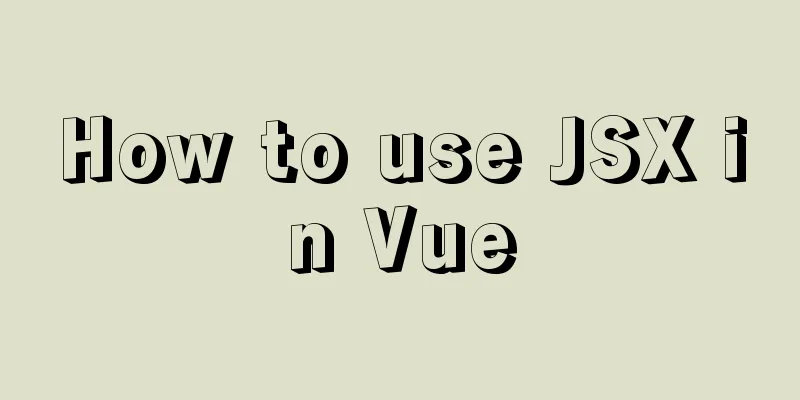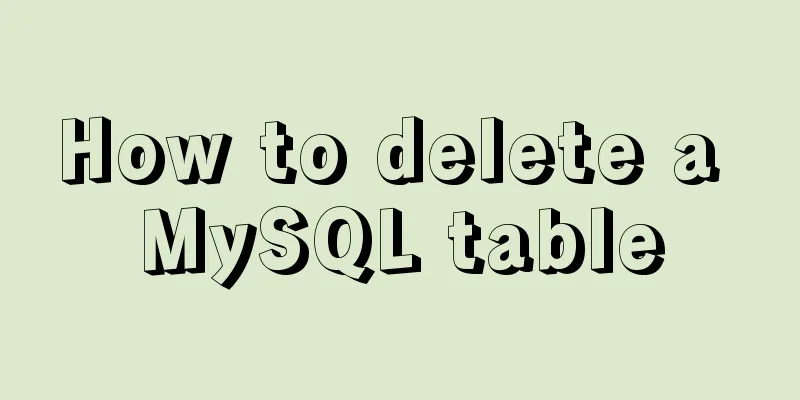How to use JSX in Vue

What is JSXJSX is a syntax extension of Javascript, JSX = Javascript + XML, that is, writing XML in Javascript. Because of this feature of JSX, it has the flexibility of Javascript and the semantics and intuitiveness of HTML. Why use JSX in Vue?Sometimes, we use render functions to abstract components. Render functions are not very clear, please refer to the official documentation, and render functions are sometimes very painful to write.
createElement(
'anchored-heading', {
props: {
level: 1
}
}, [
createElement('span', 'Hello'),
' world!'
]
)The corresponding template is as follows: <anchored-heading :level="1"> Hello world! </anchored-heading> This is obviously a thankless task, and this is where JSX comes in. To use JSX in Vue, you need to use the Babel plugin, which allows us to return to a syntax closer to the template. Next, let's start writing JSX in Vue. startQuickly create a Vue project and use vue-cli to create a project: # Just press Enter vue create vue-jsx Installation dependencies: npm install @vue/babel-preset-jsx @vue/babel-helper-vue-jsx-merge-props Configure .babelrc:
module.exports = {
presets: [
'@vue/cli-plugin-babel/preset',
['@vue/babel-preset-jsx',
{
'injectH': false
}]
]
} Basic contentHere we show some basic content written in Vue, including plain text, dynamic content, label usage, and custom component usage, which are similar to the single-file components we usually use, as shown below:
render() {
return (
<div>
<h3>Contents</h3>
{/* Plain text */}
<p>hello, I am Gopal</p>
{/* Dynamic content */}
<p>hello { this.msg }</p>
{/* Input box*/}
<input />
{/* Custom components */}
<myComponent></myComponent>
</div>
);
} Attributes/PropsAttributes binding is the same as normal HTML structure
render() {
return <div><input placeholder="111" /></div>
}Note that if the dynamic attribute is v-bind:placeholder="this.placeholderText" before, it becomes placeholder={this.placeholderText}
render() {
return <input
type="email"
placeholder={this.placeholderText}
/>
}We can also expand an object
render (createElement) {
return (
<button {...this.largeProps}></button>
)
}Like the input tag, you can batch bind attributes as follows
const inputAttrs = {
type: 'email',
placeholder: 'Enter your email'
};
render() {
return <input {...{ attrs: inputAttrs }} />
} SlotsLet's see how to implement named slots and scoped slots. Named slots: The parent component is written similarly to the single-file component template, and the location to be inserted is specified by slot="header". The subcomponent specifies the name of the slot through this.$slots.header, where header is the name of the slot. Parent component:
render() {
{/* named slot */}
<myComponent>
<header slot="header">header</header>
<header slot="content">content</header>
<footer slot="footer">footer</footer>
</myComponent>
}Subcomponents:
render() {
return (
<div>
{/* Plain text */}
<p>I am a custom component</p>
{this.$slots.header}
{this.$slots.content}
{this.$slots.footer}
</div>
);
}Scoped slots: In the child component, {this.$scopedSlots.test({ user: this.user })} specifies that the name of the slot is test, and passes the user to the parent component. When the parent component writes the subcomponent tag, it specifies the insertion position as test through the scopedSlots value, and obtains the user value passed in by the subcomponent in the callback function. Parent component:
render() {
{/* named slot scope slot*/}
<myComponent {
...{
scopedSlots: {
test: ({user}) => (
<div>{user.name}</div>
)
}
}
}>
</myComponent>Subcomponents:
render() {
return (
<div>
{this.$scopedSlots.test({
user: this.user
})}
</div>
);
} instructionCommon instructions are as follows:
render() {
{/* instructions */}
{/* v-model */}
<div><input vModel={this.newTodoText} /></div>
{/* v-model and modifiers*/}
<div><input vModel_trim={this.tirmData} /></div>
{/* v-on listener event*/}
<div><input vOn:input={this.inputText} /></div>
{/* v-on listener events and modifiers*/}
<div><input vOn:click_stop_prevent={this.inputText} /></div>
{/* v-html */}
<p domPropsInnerHTML={html} />
} Functional ComponentsA functional component is a stateless, instanceless component. For details, see the official website. Create a new FunctionalComponent.js file with the following content:
export default ({ props }) => <p>hello {props.message}</p>The parent component is called as follows:
import funComponent from './FunctionalComponent'
...
render() {
return {/* Functional component*/}
<funComponent message="Gopal"></funComponent>
}The above is the details of how to use JSX in Vue. For more information about using JSX in Vue, please pay attention to other related articles on 123WORDPRESS.COM! You may also be interested in:
|
<<: Solve the problem of being unable to log in when installing MySQL on mac using homebrew
>>: Example of how to start a container with multiple network interfaces using docker
Recommend
A few things about favicon.ico (it’s best to put it in the root directory)
Open any web page: for example, http://www.baidu....
Detailed explanation of the causes and solutions of conflicts between filters and fixed
Problem Description When filter attribute is used...
Detailed explanation of the differences between the four types of positioning in CSS
We all know that the commonly used positioning me...
Detailed example of using case statement in MySQL stored procedure
This article uses an example to illustrate the us...
Detailed steps to change the default password when installing MySQL in Ubuntu
Step 1: Enter the directory: cd /etc/mysql, view ...
Sitemesh tutorial - page decoration technology principles and applications
1. Basic Concepts 1. Sitemesh is a page decoratio...
Install MySQL 5.7.18 using rpm package under CentOS 7
I have been using MySQL recently. The article mys...
html+css+js to realize the function of photo preview and upload picture
Preface: When we are making web pages, we often n...
A brief discussion on the optimization of MySQL paging for billions of data
Table of contents background analyze Data simulat...
Vue implements sample code for dragging files from desktop to web page (can display pictures/audio/video)
Effect If you use it, please optimize the code an...
Use of js optional chaining operator
Preface The optional chaining operator (?.) allow...
Implementation of Nginx configuration of multi-port and multi-domain name access
To deploy multiple sites on a server, you need to...
jQuery implements employee management registration page
This article example shares the specific code of ...
The latest graphic tutorial of mysql 8.0.16 winx64 installation under win10
In order to download this database, it takes a lo...
How to run .sh files in Linux system
There are two ways to run .sh files in Linux syst...









